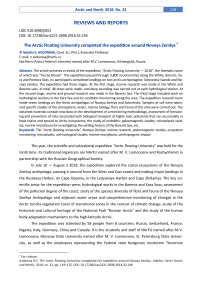The Arctic Floating University completed the expedition around Novaya Zemlya
Автор: Natalia S. Avdonina
Журнал: Arctic and North @arctic-and-north
Рубрика: Reviews and reports
Статья в выпуске: 32, 2018 года.
Бесплатный доступ
The article presents a review of the expedition “Arctic Floating University — 2018”, the thematic name of which was “Terrae Novae”. The expedition passed through 3,800 nautical miles along the White, Barents, Kara and Pechora Seas. Its participants completed landings on two arctic archipelagoes: Solovetsky Islands and Novaya Zemlya. The expedition had three stages. At the first stage, marine research was made in the White and Barents seas. In total, 48 stops were made, and deep sounding was carried out at each hydrological station. At the second stage, marine and ground research was made in the Barents Sea. The third stage included work on hydrological sections in the Kara Sea and ice condition monitoring along the area. The expedition research team made seven landings on the Arctic archipelagos of Novaya Zemlya and Solovetsky. Samples of soil were taken, and specific studies of the atmosphere, water, marine biology, flora and fauna of the area were carried out. The obtained materials contain new data on the development of a monitoring methodology, assessment of forecasting and prevention of risks associated with biological transport of highly toxic pollutants that can accumulate in food chains and spread to Arctic ecosystems; the study of endoliths; paleomagnetic studies; microplastic studies; marine microfauna for investigating the settling history of the Barents Sea, etc.
The “Arctic floating university”, Novaya Zemlya, marine research, paleomagnetic studies, ecosystem monitoring, microplastic, soil-ecological studies, marine microfauna, anthropogenic impact
Короткий адрес: https://sciup.org/148318526
IDR: 148318526 | УДК: 910.4(98)(045) | DOI: 10.17238/issn2221-2698.2018.32.146
Текст научной статьи The Arctic Floating University completed the expedition around Novaya Zemlya
This year, the scientific and educational expedition “Arctic Floating University” was held for the tenth time. Its traditional organizers are NArFU named after M. V. Lomonosov and Roshydromet in partnership with the Russian Geographical Society.
In July 10 — August 2 2018, the expedition explored the costal ecosystems of the Novaya Zemlya archipelago, passing it around from the West and East coasts and making major landings in the Russkaya Harbor, on Cape Opasniy, in the Ledyanaya Harbor and Сape Zhelaniya. The key scientific areas for the expedition were: hydrological works in the Barents and Kara Seas; assessment of the pollution degree of the coast; study of the species diversity of flora and fauna of the Novaya Zemlya Archipelago and adjacent water areas and comprehensive monitoring of changes in the Arctic tundra vegetation cover of transitional zones in the context of climate change; study of the historical and cultural heritage of the National Park “Russian Arctic” and the study of the human body adaptation mechanisms to the high-latitude Arctic.
The expedition was attended by 58 people from 8 countries: Russia, Switzerland, France, Nigeria, Italy, Germany, China and Canada. It is the students and staff of NArFU named after M.V. Lomonosov, Moscow State University named after M. V. Lomonosov, St. Petersburg State University, as well as the employees representing the Federal state budgetary institution “Severnoe
∗ For citation:
UGMS”, SSC “Arctic and Antarctic research Institute”, Volgograd State University, Novosibirsk State University, the RAS Institute of Geography, the National Park “Russian Arctic”, the University of Geneva, the University of Lausanne, and the Federal Polytechnic school of Lausanne.
The expedition “AFU-2018” passed 3 800 nautical miles across the White, Barents, Kara and Pechora Seas; its participants visited 2 Arctic archipelagos: the Solovetsky Islands and Novaya Zemlya.
The expedition was called “Terra Novae” and included three stages. First, marine studies were carried out in the White and Barents Seas. A total of 48 stops were made. Deep sensing was carried out at each hydrological station. The sensors fixed pH and alkalinity levels. Rosetta with bathometers was lowered by a maximum of 285 meters, determining, among the other things, the presence of microplastics in the water. Three hydrological sections were made in the White Sea and one in the Barents Sea. Preliminary data helped the researchers to draw conclusions about the strong contamination of the Barents Sea. Also, at the first stage, samples of phyto- and zooplankton were selected to study the content of eco-toxicants.
At the second stage, marine research in the Barents Sea was continued and land works were started. E.g., three land teams were working in the Russkaya Harbor to collect geological and biological samples and “marine garbage”. The latter group was studying how the garbage accumulated on the shores of the Novaya Zemlya.
The third stage included work on hydrological sections in the Kara Sea and monitoring of ice. The NArFU staff and students were monitoring the ice, quickly assessing the physical characteristics of ice total concentration, the presence of ice of different age, crush of ice. Such works are necessary for the data bank for observations of the ice fields movement and drift. In future, these materials will be used to develop recommendations on the shipping along the Northern Sea Route.
During the expedition, the researchers made seven landings on the Arctic archipelagoes of Novaya Zemlya and Solovetsky. Soil samples were taken, atmosphere, water, marine biology, flora and fauna of the area were studied.
NArFU scientists continued research started in 2017 as part of a mega-grant. The aim was to develop a methodology for monitoring, evaluating, forecasting and preventing the risks associated with the transfer of highly toxic pollutants along biological pathways, e.g. commercial fish and birds. Pollutants get into food chains and spread in the Arctic ecosystems. On the islands of the Novaya Zemlya Archipelago, employees of the NArFU Laboratory of Ecological Biomonitoring selected samples, incl. soil, bird eggs, liver and fish fillets (cod and haddock), freshwater and bottom sediments, zoo- and phytoplankton, for the subsequent metagenomic analysis and determination of ecotoxicants concentrations in the food chains. On the Kolguev Island, scientists could get blood samples of the local populations. People we also asked to fill in questionnaires about their health.
Oceanographic studies were made in 7 oceanographic sections in the White, Barents and Kara Seas. 58 stations were worked out. Samples were taken to determine the thermohaline char- acteristics of water for the further study of the Atlantic water masses transformation in the western sector of the Russian Arctic.
Hydrobiological research made by the NArFU staff is based on 30 selected samples of zoo-and phytoplankton for subsequent analysis in the Laboratory of the NArFU Center for Arctic Biomonitoring.
Within the framework of soil-ecological research, scientists from the Institute of Geography of the Russian Academy of Sciences and the Moscow State University named after M.V. Lomonosov laid 14 soil sections and described 28 horizons of soil profiles; 112 samples were taken for physical, chemical and microbiological analyzes in the laboratory. The most northern endolithic soil-like bodies (endolites) in Russia and Eurasia, representing a specific complex of microbial associations hidden inside the rocks, were found at Cape Zhelaniya.
Geologists from the Novosibirsk State University continued the research by the team of the Laboratory of Geodynamics and Paleomagnetism of the Central and Eastern Arctic during the expeditions “APU — 2016” and “APU — 2017”, as well as previous expeditions of 2014 and 2015 [1– 7]. Scientists from the NSU took 113 oriented samples for paleomagnetic studies. The results will be used in reconstructions of the crustal blocks drift during the formation of the modern structure of the Arctic margin of Eurasia.
In the framework of terrestrial biological research and the study of terrestrial microfauna of the Arctic archipelago, samples were collected for taxonomic analysis of the fauna of the sedge moor of the Island of the Novaya Zemlya Archipelago. For the first time, insects were collected from aquatic and coastal biotopes of freshwater bodies and watercourses (puddles, lakes, streams, and rivers) of the Novaya Zemlya along the coast of the Kara Sea (near the Bay of Blagop-oluchiya and Ledyanaya Harbor). For the first time, a massive material was obtained from adult larvae of two-winged insects (mosquitoes and flies) from their larvae and pupae, which develop in the main freshwater and coastal (semi-aquatic) biotopes of the North of New Earth. In the future, this material will allow us to accurately determine the species composition of dipterans undergoing development in the corresponding biotopes. For the first time, communities and the composition of the invertebrate’s population (mostly dipterans) were studied in semi-aquatic biotopes in 4 districts of northern Novaya Zemlya (the environs of Russkaya Harbor, Cape Zhelaniya, Bay of Blagopoluchiya and Ledyanay Harbor). Data was collected to study the fauna and insect communities of sphagnum - sedge moor near Cape Kanin Nos. It was obtained for the moors of the tundra in the western part of the European territory of Russia for the first time.
In 2018, for the first time, The APU expedition completed a research of microplastic distribution. Scientists practiced the methodology of sampling and analysis. Samples were taken at 15 stations, 12 of them have been processed by now. Under the microscope, 1 009 particles less than 5 mm were identified. According to preliminary results, we can say that the Barents sea is the most polluted with microplastic, and the least polluted one is the Kara sea.
Studies of marine microfauna are of a particular interest: scientists collected mollusks to use them as a model group to study the genetic diversity of the fauna in the Barents Sea and neighboring areas. Samples were taken from the fjords and bays along the Northern coast of the Novaya Zemlya Archipelago. Studies of the Barents Sea marine microfauna will provide a better understanding of the history of its settlement.
Another area for research onboard Professor Molchanov was the anthropogenic impact on the NSR ecosystem. Samples of fuel and solid particles (17 in total) from 6 fuel-using installations. These elements are carried by exhaust gases through chimneys to the environment. Information on the structure and operation of the mechanisms and units of the research vessel's power plant was also collected.
The study contributes to a better understanding of the soot formation in the combustion chambers of auxiliary boilers and internal combustion engines of ships, to assess the quantitative and elemental composition, shape and size of emitted particles, shape and dimensions of the selected particles, to clarify the coefficients for calculating emissions of fine PM2.5 particles
During the landings, 35 snow samples were collected to determine organic compounds and metals using the ICP-MS method, black carbon and dust. 10 air sorption tubes were obtained to the determine volatile and semi-volatile components.
As it was noted by the head of the expedition, NArFU Vice-rector for International Cooperation Konstantin S. Zaykov, the results of the “Arctic floating University — 2018” not only continued the scientific work of the past years, but also opened up new research horizons for the study of the Western sector of the Arctic. In addition, the expeditions of the Arctic floating University are undoubtedly an innovative type of education in the context of modernization of the higher education.
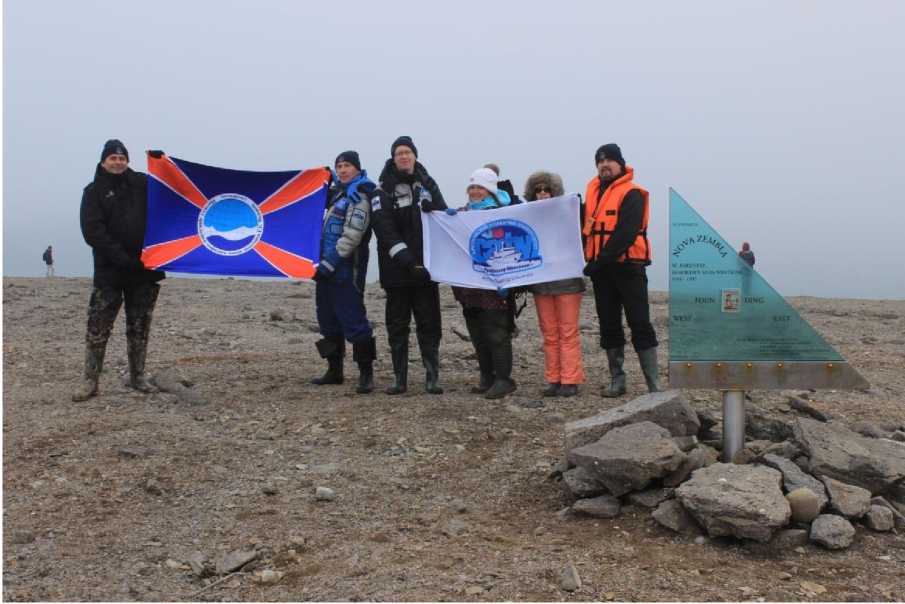
Fig. 1. NArFU staff at Cape Zhelaniya.
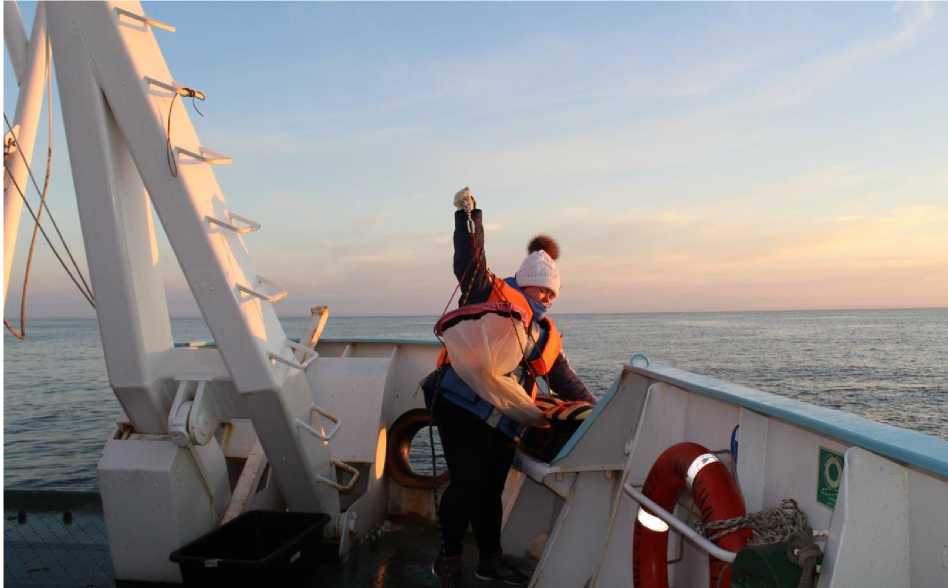
Fig. 2. The employee of the Lab for the Arctic Biomonitoring Anna Trophimova collects samples of zoo- and phytoplankton.
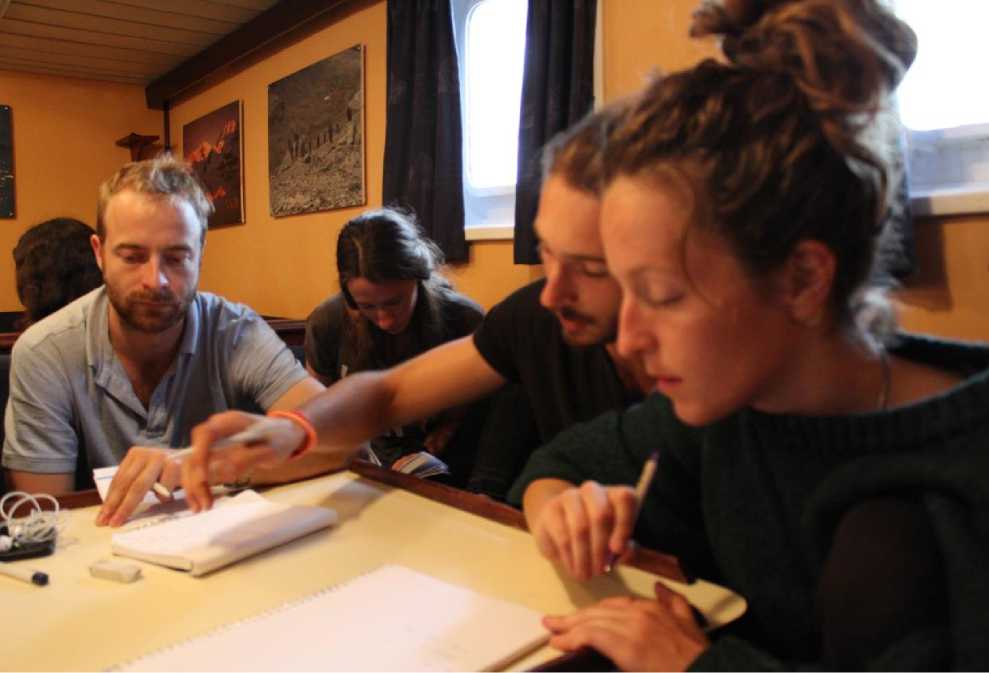
Fig. 3. Students onboard of “Professor Molchanov”.
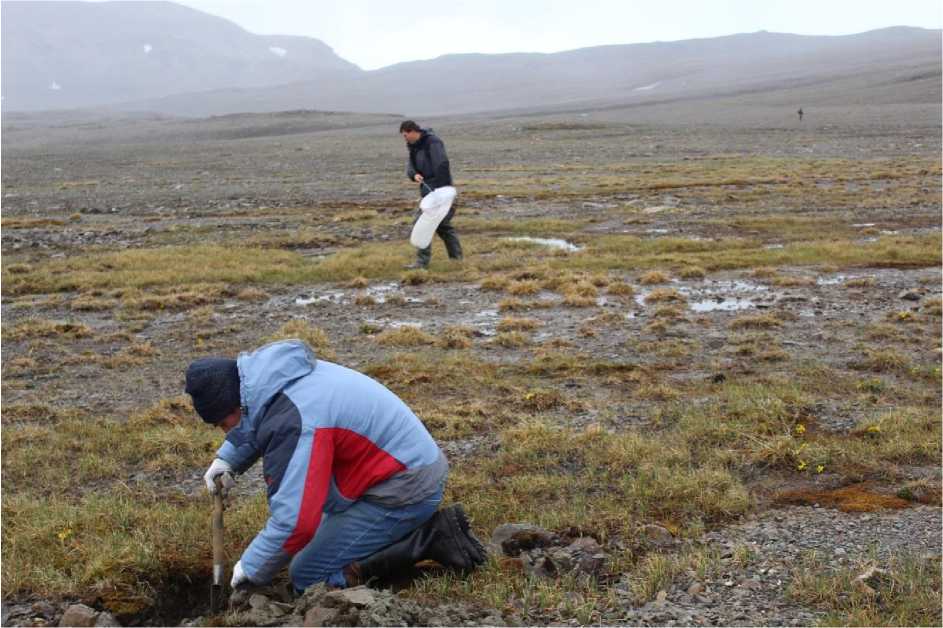
Fig. 4. Botanists’ field work in Harbor Russkaya.
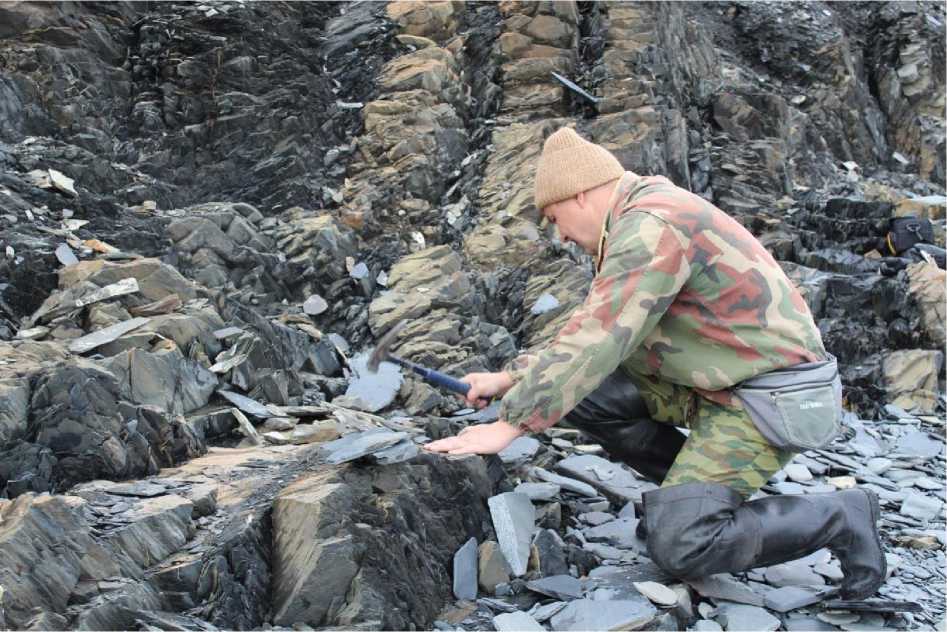
Fig. 5. Geologists at the Cape Opasniy.
Список литературы The Arctic Floating University completed the expedition around Novaya Zemlya
- Bugaenko O.D., Vorozhtsova L.A., Gur'ev A.A., Zaikov K.S., Zarubina L.A., Korshunov A.A., Kudryashov Yu.V., Kudryashova E.V., Kukarenko N.N., Nikulina N.V., Polikin D.Yu., Ryabchenko S.V., Filippov B.Uu. SAFU: arkticheskim kursom [NArFU: Arctic vector]. Arhangel'sk, NArFU Publ., 2016, 152 p. (In Russ.)
- Vasil'ev L.N., Drachkova L.N., Zaikov K.S. Postigaja Russkuju Arktiku. Ob itogah mezhdunarodnoj kompleksnoj nauchno-obrazovatel'noj jekspedicii «Arkticheskij Plavuchij universitet-2015» [On the results of the international complex scientific and educational expedition “Arctic Floating University-2015”], Trudy Arhangel'skogo centra Russkogo geograficheskogo obshhestva: sbornik nauchnyh statej. Arhangel'sk, 2015, pp. 3–8. (In Russ.)
- Drachkova L.N., Zaikov K.S. Arkticheskij plavuchij universitet: vchera, segodnja, zavtra [Arctic floating university: yesterday, today and tomorrow], Vestnik NArFU. Series: Estestv. nauki, 2016, no. 4, pp. 87–89. DOI: 10.17238/issn2227-6572.2016.4.87
- Zaikov K.S., Kalinina M.R., Kondratov N.A., Tamitskiy A.M. Strategicheskie prioritety nauchnyh issledovanij Rossii i zarubezhnyh gosudarstv v Arkticheskom regione [Strategic priority of scientific research of Russia and foreign countries in the Arctic region], Arktika: jekologija i jekonomika [Arctic: Ecology and Economy], 2016, no. 3 (23), pp. 29–37.
- Zaikov K.S., Kalinina M.R., Kondratov N.A., Tamitskiy A.M. Innovacionnyj vektor jekonomicheskogo razvitija severnyh i arkticheskih territorij Rossii i stran Severnoj Evropy [Innovative vector of the economic development of the Northern and Arctic territories of Russia and Northern Europe], Jekonomicheskie i social'nye peremeny: fakty, tendencii, prognoz, 2017, vol. 10, no. 3, pp. 59–77.
- Zaikov K.S., Rjabchenko S.V. Problemy podgotovki nauchnyh kadrov dlja osvoenija i razvitija AZRF [The problems of preparing researchers to exploring and developing Arctic Region of Russian Federation], Monitoring i ocenka razvitija territorij Arkticheskoj zony: materialy Mezhdunar. nauch.-prakt. konf. (g. Arhangel'sk, 19–20 maja 2016 g.). Arhangel'sk, 2016, pp. 307–310. (In Russ.)
- Kostovska S.K., Nekrich A.S., Polikin D.Yu., Zaikov K.S., Kostovska St.K., Polikina L.N. Nauchnye I obrazovatel'nye programmy kompleksnyh issledovanij Rossijskoj Arktiki [Scientific and educational programs of complex research of the Russian Arctic], Problemy regional'noj jekologii [Regional Environmental Issues], 2016, no. 1, pp. 58–65.

